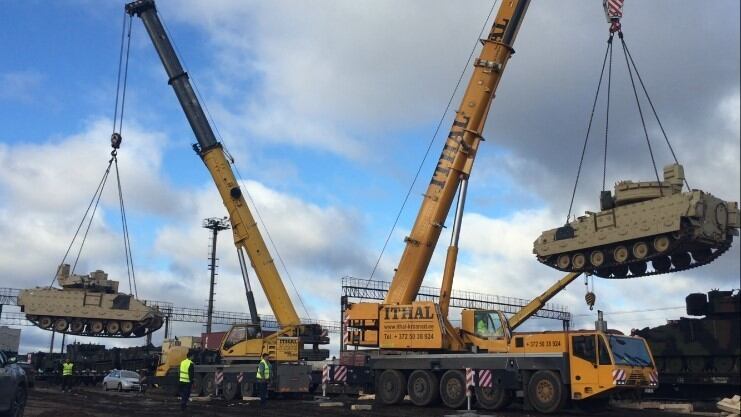The op Pentagon officials are is discussing plans to permanently move one or more Army brigade combat teams back to Europe, where the top American commander has signaled an urgent need to shore up allied defenses against the Russians, Military Times has learned a vastly larger Russian force, defense officials said.
If approved, the move could involve thousands of troops — an average BCT is composed of between 3,000 and 5,000 personnel — and mark the first time in decades that U.S. European Command has increased its footprint on the continent forces in decades.
The EUCOM Commander, Air Force Gen. Philip Breedlove, discussed his the proposals with top-level Pentagon officials while in during his trip to Washington last week, according to a defense official familiar with the plans. Any increase in the permanent force level for EUCOM would come in addition to the brigade-size force that a would rotate through deploy to Eastern Europe on a rotational basis as part of the $3.4 billion "European Reassurance Initiative," which was included in the Pentagon’s latest budget request.
"They are looking at ways to increase the permanent Army forces in Europe," the defense official said. "They're trying to figure out ‘how much do we need, and where would it come from?’"
Breedlove is concerned voiced concerns about the size of the current ground force in Europe, which includes two Army combat brigades. That's down from four brigades a few years ago.
"We do not have, in my opinion, enough U.S. forces permanently stationed forward … so I believe that the permanent forces forward need to be reviewed," Breedlove, who also serves as NATO's supreme commander, told reporters on March 1.
These high-level discussions at the Pentagon come amid growing worry concern that the U.S. and NATO forces would be quickly overwhelmed in a fight against the far larger Russian force aligned along NATO’s eastern border. A recent series of classified war-game exercises, featuring with scenarios forecasting involving Russian military advances into Europe, is across NATO’s eastern border was summarized in a report released in February from the RAND Corp.
"The outcome was, bluntly, a disaster for NATO," the study concluded. "By and large, NATO's infantry found themselves unable even to retreat successfully and were destroyed in place," the report said, noting that the current posture of U.S. and NATO forces is "potentially inviting a devastating war, rather than deterring it."
The RAND researchers concluded that the ideal force in Europe — from both U.S. and NATO countries — would include seven brigades, including three with heavy armored brigades. The Russian military currently maintains a force of about 22 maneuver warfare battalions in its "Western Military District" along NATO’s border, according to the RAND study.
For now, EUCOM's contingency plans for a conflict with Russia relies the two garrisoned light infantry brigades — the 173rd Airborne out of Vicenza, Italy, and the 2nd Cavalry Regiment in Vilseck, Germany — plus and a growing store of forward-deployed, prepositioned weapons and vehicles throughout Eastern Europe that would allow personnel to rapidly "fall in" and quickly join the fight begin operations.
Beyond that, the U.S. and Europe would rely on "rapid reinforcement" with Army units based in the United States. The Pentagon's current budget proposal for next year includes money for "investments in ports, rail heads and railroads, and airfields so that we can rapidly receive, and then deploy and employ forces," Breedlove said.
Yet experts say moving heavy armored brigades from the United States to NATO's eastern border would take weeks or even months.

Troops unload Bradlee Fighting Vehicles at a rail yard near the Tapa Training Area in Estonia.
Photo Credit: Chief Warrant Officer 2 Lew Robinson/Army
Military officials caution that any final decision on moving troops faces many hurdles. Inside the Pentagon, the issue would trigger a budget battle over who — or what account — will pay for the a EUCOM increase. And in Europe, it the increase would require approval from allies and an agreement with a host nation.
One major question for the U.S. is where those additional Army forces might be located, either in traditional Army garrison facilities in Germany or possibly closer to Russia, to the east in Poland or the Baltic countries.
"There are advantages and disadvantages to both, said David Ochmanek, a former Pentagon official who is now a senior defense analyst at RAND. "A force that is very forward could conceivably be vulnerable to a preemptive attack by short-range missiles or special forces," Ochmanek said. "A force in Germany would be safer from such an attack but would have to move quickly to the border in the event of a conflict," he said."
Ochmanek said he believes the best option involves putting significant combat forces in Eastern Europe where they can respond more quickly.
"There really is no substitute for having heavy combat forces, armored brigades and mechanized infantry, forward in the battle space," he said.
Today, the American 's force in Europe numbers about 65,000, U.S. troops is down significantly from has dropped steadily since its Cold War-era peak of more than 200,000 in the 1980s.
The U.S. Army had four brigades in Europe until 2012, when it decided to deactivate two of them, leaving Europe with no U.S. Army tanks. Recently, the Army has returned more than 200 have vehicles, but those are prepositioned in warehouse and not attached to permanent combat units.
In January, the National Commission on the Future of the Army released its final report recommending the return of at least one armored brigade to Europe.
Responding to renewed Russia aggression has been a topic of intense debate in Washington for the past two years since Moscow sent troops into Ukraine and seized the Crimea peninsula. In 2014, then-former Defense Secretary Chuck Hagel reportedly urged the White House to take a more aggressive response to Russia and to do more to reassure NATO allies along Russia’s border.
In the summer of 2015, the Pentagon dusted off its outdated war plans for Russia and assigned several top officials to revise them for the current threat.
Andrew Tilghman is the executive editor for Military Times. He is a former Military Times Pentagon reporter and served as a Middle East correspondent for the Stars and Stripes. Before covering the military, he worked as a reporter for the Houston Chronicle in Texas, the Albany Times Union in New York and The Associated Press in Milwaukee.





